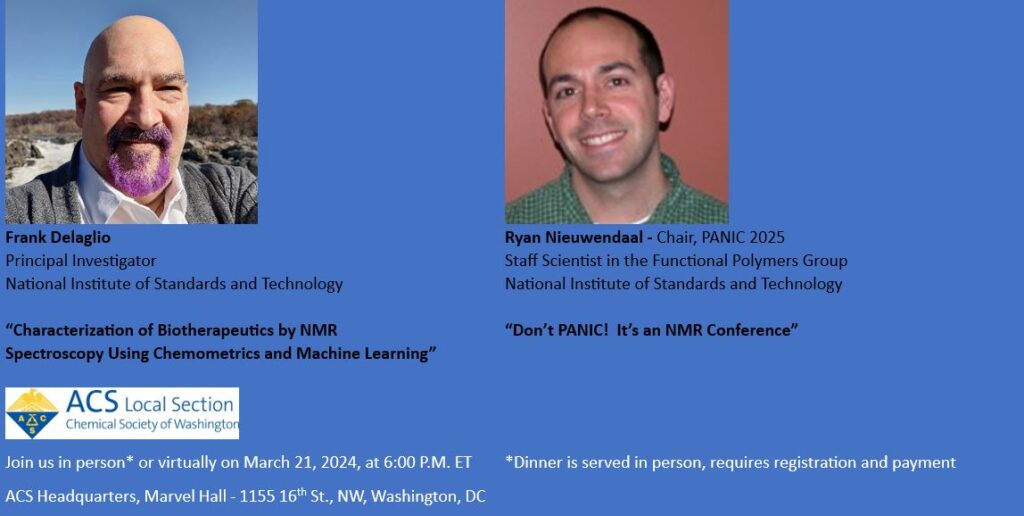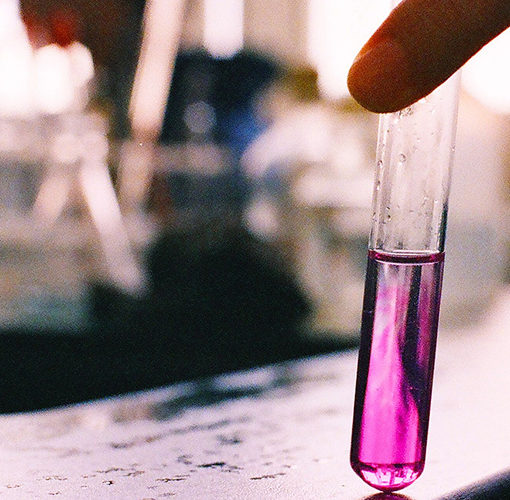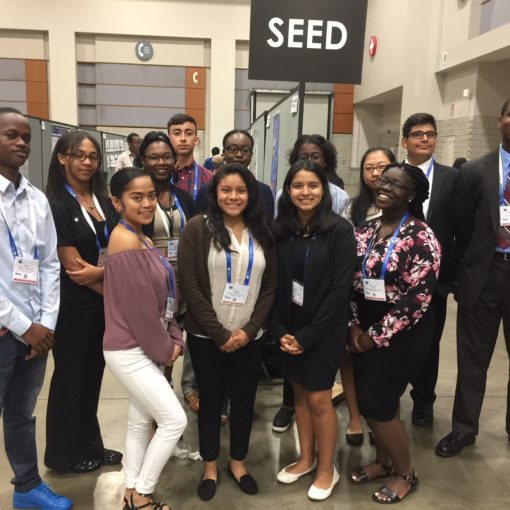
Meeting Logistics
Date: Thursday, March 21, 2024
Time: 6:00 p.m. Check-in/Social Hour
6:30 p.m. Dinner
7:00 p.m. Speaker Presentation
Location: ACS Headquarters – Marvel Hall / Othmar Hall
1155 16th St., N.W., Washington, DC
Menu: Meal will be catered by Everfresh Catering and will feature stir fry with chicken and beef. Vegetarian Option features vegan tofu vegetable stir fry. Sides include vegetable fried rice, steamed vegetables, salad, and cookies and brownies. Beverages will be provided.
Cost: $22 per person (half price for students) for dinner
An RSVP is required for dinner so we can plan appropriate seating and meals.
Register for the virtual option via Zoom.
RSVP by noon (ET) Tuesday, March 19, to [email protected]. Please provide the names in your party as well as your contact information when you RSVP. The public is invited to attend. You may attend the talk only at no charge, but reservations are appreciated. If you need any further information or would like to make a reservation, please contact the CSW office by email at [email protected].
Parking: Parking is available in nearby commercial parking garages. Please be aware that garage closing times vary. Parking is also available on the street after 6:30 pm, but be aware that most parking meters are in effect until 10:00 pm and may be limited to 2 hours. You should check the individual meters for details and payment methods as some are no longer coin-operated.
Metro: Blue/Orange/Silver Line: McPherson Square or Farragut West.
Red Line: Farragut North
Speaker Bios:
Ryan Nieuwendaal Ryan is a Staff Scientist in the Functional Polymers Group at the National Institute of Standards and Technology, the metrology lab of the United States Federal Government. Working in the Department of Commerce, he performs solid state nuclear magnetic resonance (NMR) experiments towards understanding the local packing structures and molecular dynamics that occur in materials of industrial relevance, ultimately to establish structure-property relationships. Nanoscopic details such as atomic connectivity, interfacial structure, and mesophase order can be obtained from 1H spin diffusion and discrete internuclear dipolar couplings (i.e., REDOR), even in the absence of long-range order. Hence, nanoscale models can be reliably developed for heterogeneous systems like semi-crystalline polymers, polymer blends, and polymer networks; all of which are utilized in commercially relevant materials. Over the course of his career, he has published articles mainly involving solid-state NMR of materials.
Frank Delaglio is a Principal Investigator at the National Institute of Standards and Technology, developing computational methods for Nuclear Magnetic Resonance (NMR) data to support development and manufacturing of drugs and vaccines, and to support basic research in structural biology. Frank’s current focus is development of approaches for characterization of monoclonal antibody drugs and live cell therapies, so that these important therapeutics can continue to be safe and effective, and become more accessible and affordable. His interests include multidimensional spectral processing and analysis, chemometrics and machine learning, and data visualization. In the NMR community, Frank is best known for developing the NMRPipe software system while on the staff at the US National Institutes of Health. The software has been cited over 15,000 times in peer-reviewed literature, and has been used to help generate over 40% of protein structures ever measured by NMR. Frank’s career includes commercial software development, extensive pharma consulting, and regular participation as an advanced course instructor for the European Molecular Biology Organization. Frank earned a BA in Chemistry from Syracuse University, and a PhD from the Osaka University Graduate Department of Pharmaceutical Sciences.
Speaker Abstracts:
Having just celebrated its 10th annual conference, the Practical Applications of NMR in Industry Conference, or “PANIC”, has served as a place for industrial, regulatory, government and academic scientists to share day-to-day aspects of NMR-related research. As a conference that is dedicated solely to the practical aspects of NMR, attendees regularly share details that are rarely discussed at other NMR meetings, making PANIC a rare opportunity to broaden knowledge, exchange ideas of the latest NMR developments, and discuss the nitty-gritty details of how to get NMR experiments to work. In this brief introduction to PANIC, I will highlight a few vignettes from previous PANIC conferences, discuss what PANIC has coming up this year, and share details of our next in-person conference in 2025. Hopefully, everyone will see how fun (and practical!) NMR can actually be!
Protein therapeutics are vitally important clinically and commercially, with monoclonal antibody (mAb) therapeutic sales alone accounting for $180 billion in revenue for 2022. In order for these therapies to be safe and effective, their protein components must maintain their three dimensional fold and not aggregate. Nuclear magnetic resonance spectroscopy (NMR) is powerful and diverse tool to characterize this higher order structure of protein therapeutics, because NMR spectra are sensitive to molecular shape and intermolecular interactions as well as chemical structure, and NMR can reproducibly probe this information at atomic resolution. Furthermore, NMR has the advantage that it can be applied non-destructively to protein therapeutics as-formulated, with little or no sample preparation. Intriguingly, since NMR can also be applied to quantify the small molecule mixtures comprising the metabolome, NMR has the potential to characterize the growth metabolomics of the cells used in large scale to manufacture mAbs, and also the cells manufactured in small scale for personalized live cell therapies such as CAR-T cancer treatment. Exploiting NMR for these biomanufacturing needs leads to a series of computational challenges which we review, including metrics of spectral similarity, data handling for applications of principal component analysis (PCA), spectral analysis of mixtures, and identification of spectral features by computer vision and machine learning.




